Both Artisan and ICL are safe, effective in high myopic correction, surgeons say
Phakic intraocular implants are having increasing success in refractive surgery, studies show.
ALGARVE, Portugal – Phakic intraocular implants are having increasing success in refractive surgery, according to studies reported during the meeting of the European Society of Cataract and Refractive Surgeons here.
“We are working with all types of phakic implants,” said Carlos Moedas, MD, of Hospital Ordem Terceira (Lisbon), “and we can say that, thanks to the latest improvements, they are all valuable and reliable options. Once you know the specific features of each type, are aware of their potential drawbacks together with carefully evaluating the patient’s history, you can’t go wrong with your choice.”
At Lisbon Hospital, phakic IOLs are generally used to correct high myopia (10 D or greater) and hyperopia greater than 5 D.
At the meeting, Dr. Moedas presented his results with the ICL (STAAR Surgical AG; Nidau, Switzerland), while a colleague from the same clinic, Francisco Loureiro, MD, discussed the Artisan lens (Ophtec BV; Groningen, Netherlands).
No cataract with ICLs
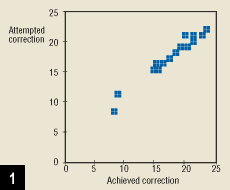 |
| Correction between ±1 of intent was achieved in 82% of ICL patients. |
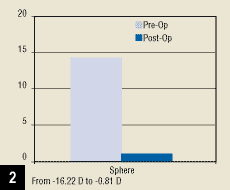 |
| The spherical equivalent patients. was reduced from mean –16.22 D to a mean –0.81 D in ICL |
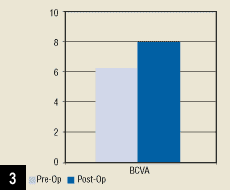 |
| Best corrected visual acuity was raised an average of two lines in ICL patients. |
Dr. Moedas spoke very favorably about ICLs. “They were very controversial until a few years ago,” he said, “and it is true that in the past, posterior chamber phakic IOL meant all kinds of complications and a high number of cataracts. However, the lens we use now is far from what it used to be, and its performance also is very different.”
The latest V4 model, according to the surgeon, has enhanced biocompatibility, is extremely thin and easy to insert, comfortable in the eye, effective on visual acuity and provides sufficient vaulting to prevent opacification of the crystalline lens.
At Hospital Ordem Terceira (Lisbon), 36 patients (age range 22 to 50) were implanted with ICLs in the past 3 years, for a total of 50 eyes. Myopia ranged from 5 D to 33 D and hyperopia from 5 D to 8 D.
Correction between ±1 was achieved in 82% of patients (figure 1). The spherical equivalent was reduced from mean –16.22 D to a mean –0.81 D (figure 2).
Best corrected visual acuity was raised an average of two lines (figure 3).
“Our follow-up is still too brief to crow over a victory, but so far we haven’t seen any important complications. We are aware that cataract is the big issue at stake, but we are optimistic,” he said.
For safe and successful surgery, and to prevent cataracts in particular, Dr. Moedas suggested three important points:
- Implant the lens correctly and avoid trauma. Take your time, and keep it simple. Do not touch the optical zone; it is very thin. Do not drag the ICL.
- A good vault is extremely important. Therefore, the correct white-to-white measurement is crucial.
- Ask your patients to be regular with periodic check-ups, and to stay with you.
“When patients come to me for ICLs, they should know that they have to be my patients for the rest of their lives,” Dr. Moedas said. “In fact, it doesn’t matter how well the operation went or how good the vault is. There is always a possibility that, in the long term, the ICL may lose vault. This, in addition to the natural growth of the crystalline lens in the aging process, may produce a progressive reduction of the space, with consequent adhesion and onset of cataract.”
Age is, in fact, according to Dr. Moedas, one of the four important elements to be taken into consideration when calculating the probability of cataract formation, the others being lens trauma during surgery, vault and hereditary characteristics.
“If only one of these elements is weak, this is sufficient to create the conditions for cataract formation,” he said. “On the other hand, our results confirm that with a patient younger than 45 years, without trauma, a good vault and no family history of cataract, the chances of developing it are less than 2%.”
Predictability with the Artisan
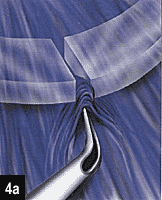
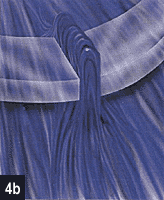 ---With the help of an
enclavation needle, an iris fold is caught by the claw of the Artisan
lens.
---With the help of an
enclavation needle, an iris fold is caught by the claw of the Artisan
lens.
The results presented by Dr. Loureiro confirmed the well-known efficacy and reliability of the Artisan lens.
“Why opt for the Artisan?” he asked. “Because it is further from the endothelium, if compared with the Baikoff Nuvita [Bausch & Lomb Surgical; Claremont, U.S.A.], and further from the lens, if compared with the ICL. Also, its 5- to 6-mm optics are more effective as a means to avoid halos.”
At Lisbon Hospital, the Artisan lens is used for myopia of between 10 D and 23 D. A few cases of higher myopia, up to 31 D, also were reported.
Selection criteria encompass a low degree of astigmatism, anterior chamber depth greater than 2.8 mm, endothelial cell count of 2,000 and no history of ocular and systemic diseases.
Dr. Loureiro reported on 19 patients implanted with the Artisan lens, for a total of 30 myopic eyes.
The mean spherical equivalent was –18 D (range of –12 D to –31 D); the mean astigmatic correction was –1.5 D (range of –0.5 D to –3.5 D).
“The lenses were implanted under general or retrobulbar anesthesia,” Dr. Loureiro said. “We prefer a vertical approach, because the tip of the enclavation needle, when it is introduced into the eye, is directly in front of the claw [figure 4]. We also used special forceps to avoid tilting of the lens and a large quantity of viscoelastic to avoid contact of the lens with the cornea. At the conclusion, we closed the ports with two sutures.”
Visual acuity results showed a gain of at least one line in 90% of patients. Residual myopia was less than 1 D in 80% of the patients and more than 1 D in the remaining 20%.
“This 20% included two highly myopic patients. One of them had a preoperative myopia of 29 D; the second one had 31 D. Undercorrection was not unexpected,” Dr. Loureiro said.
Preoperative mean astigmatism was 1.5 D and postoperative astigmatism was 0.9 D.
As for complications, Dr. Loureiro reported two cases of slight upper decentration with consequent halos.
Pigment dispersion over the IOL was observed in two cases and was easily corrected with the YAG laser. One case had minor capsular opacification.
“The Artisan lens gives good, quick and highly predictable results. It is a reversible procedure with a very low incidence of adverse events and complications. The drawback, as we all know, is that we need a fairly large incision to insert it. Let’s hope for a foldable version in the future,” Dr. Loureiro said.
For Your Information:
- Carlos Moedas, MD, and Francisco Loureiro, MD, can be reached at Hospital Ordem Terceira, R. Serpa Pinto, 1200, Lisbon, Portugal; phone/fax: +(351) 21-4945061; e-mail: cmoedas@mail.telepac.pt. Drs. Moedas and Loureiro have no direct financial interest in any of the products mentioned in this article, nor are they paid consultants for any companies mentioned.
